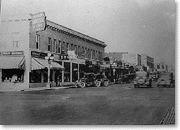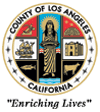How do I...?
Community History |
Frequently Asked Questions |
Local History Materials |
Image Gallery
Community Links |
Library History |
Community Profile
 San Fernando, the oldest
city in the valley for which it is named, is located about twenty three miles
north of Los Angeles, near the foothills of the San Gabriel Mountains.
Founded in 1874, it is nicknamed "The Mission City" because of its proximity
to the San Fernando Mission that was established in 1797 and on whose former
property the city emerged. San Fernando was originally populated by
Gabrielino and Tataviam Indians, the latter naming the area "Achois Comihabit,"
before Spanish explorers first passed through the region in 1769. In its
pristine state, the hills and valleys were lush with oak and walnut trees.
These gave way to ranches and farms in the nineteenth century, as an outgrowth
of activities originally undertaken by the mission which thrived for nearly
forty years during the early 1800s. During that time, while California was
still Mexican territory, a mixture of Spanish, Indian, and Mexican residents
arrived and settled in the valley. Following the mission's secularization in
1834, it went into decline and was abandoned about a decade later.
San Fernando, the oldest
city in the valley for which it is named, is located about twenty three miles
north of Los Angeles, near the foothills of the San Gabriel Mountains.
Founded in 1874, it is nicknamed "The Mission City" because of its proximity
to the San Fernando Mission that was established in 1797 and on whose former
property the city emerged. San Fernando was originally populated by
Gabrielino and Tataviam Indians, the latter naming the area "Achois Comihabit,"
before Spanish explorers first passed through the region in 1769. In its
pristine state, the hills and valleys were lush with oak and walnut trees.
These gave way to ranches and farms in the nineteenth century, as an outgrowth
of activities originally undertaken by the mission which thrived for nearly
forty years during the early 1800s. During that time, while California was
still Mexican territory, a mixture of Spanish, Indian, and Mexican residents
arrived and settled in the valley. Following the mission's secularization in
1834, it went into decline and was abandoned about a decade later.
 The city's founding in 1874 was spurred by a land boom in Southern California
and the Southern Pacific Railroad's building of a rail line between Bakersfield
and Los Angeles through Fremont Pass. Soon populated with an influx of
settlers, San Fernando became known as the railroad's "gateway to the north,"
and with its Mediterranean climate and deep wells that provided water for
irrigation, the community cultivated an abundance of vegetables and fruits,
especially citrus and olives. That independent water supply allowed San
Fernando to remain autonomous and incorporate in 1911, while most of the
valley's other communities felt compelled to annex to Los Angeles in 1915 to
avail themselves of the waters of the Los Angeles Aqueduct, which started
flowing in 1913. Today, with a population of about 22,600 people, San Fernando
is one of the valley's smaller communities but has retained its individuality
and identity with an annual fiesta in celebration of its mission days and
downtown architecture that reflects the city's longtime Mexican heritage.
More information about the community history of San Fernando can be found in
the following sources:
The city's founding in 1874 was spurred by a land boom in Southern California
and the Southern Pacific Railroad's building of a rail line between Bakersfield
and Los Angeles through Fremont Pass. Soon populated with an influx of
settlers, San Fernando became known as the railroad's "gateway to the north,"
and with its Mediterranean climate and deep wells that provided water for
irrigation, the community cultivated an abundance of vegetables and fruits,
especially citrus and olives. That independent water supply allowed San
Fernando to remain autonomous and incorporate in 1911, while most of the
valley's other communities felt compelled to annex to Los Angeles in 1915 to
avail themselves of the waters of the Los Angeles Aqueduct, which started
flowing in 1913. Today, with a population of about 22,600 people, San Fernando
is one of the valley's smaller communities but has retained its individuality
and identity with an annual fiesta in celebration of its mission days and
downtown architecture that reflects the city's longtime Mexican heritage.
More information about the community history of San Fernando can be found in
the following sources:
Website Links:

Print Sources:
- McGroarty, John Steven, ed. History of Los Angeles County. Volume I. Chicago and New York: The American Historical Society, Inc., 1923.
- Robinson, W.W. The Story of San Fernando Valley. Los Angeles: Title Insurance and Trust Company, 1961.
- Dace, Catherine Hubbard Egbert. Early San Fernando: Memoirs. Historical Society of Southern Calif., 1962.
- Smith, Clifford M. The history of San Fernando Valley: With Special Emphasis on the City of San Fernando. Masters Thesis. University of Southern California, 1930.
- Loomis, Derward P. San Fernando Retrospective: The First Fifty Years. San Fernando, CA: San Fernando Heritage, 1985.
![]()
Agoura Hills |
Antelope Valley |
Carson |
Catalina Island |
Claremont |
East Los Angeles
Gardena |
Lakewood |
La Puente Valley |
Pico Rivera |
San Dimas |
San Fernando
San Gabriel |
South Gate |
Willowbrook







